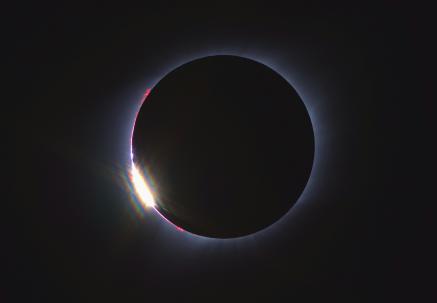Hamilton County in the Path of Totality
On April 8, 2024, a total solar eclipse will drape the Adirondack mountains and upstate New York in darkness! This rare event is an astrophotographer's paradise, and travel-lovers will find that the Adirondacks are an exceptional place, if not the best place in the country, to view the eclipse. Hamilton County, in particular, is filled with small towns and big outdoors, translating to many quiet and peaceful options for viewing the eclipse.
The path of totality for a solar eclipse can happen anywhere in the world, but more often than not the shadow casted by the eclipse lands in the ocean, near the poles, or not even hitting the Earth at all! The fact that this narrow strip of shade is running right through the Adirondacks is enough to drop what you're doing, make plans to attend an eclipse-themed event, and get excited. Why? You'll have to wait another 375 years to experience a total solar eclipse in the Adirondacks again.
When will the eclipse start, and how long does it last?
Hamilton County has numerous communities in the path of totality. Check out the FAQ below for information on the timing of totality.
The best places to watch
All around the region, businesses are organizing eclipse events, and there are parks and outdoor spaces with exceptional views of the sky. Grab your solar eclipse viewing glasses, and find the spot that suits your interest! The list and map, as well as the FAQ section below, offer some suggestions for your viewing experience.
- Adirondack Experience, The Museum on Blue Mountain Lake - A watch party with food trucks, live music, a campfire with s'mores, art activities, NASA livestream, and more! Tickets required. Parking included with admission.
- Arrowhead Park - 160 State Route 28, Inlet
- Sacandaga River Community Park & Pathway - State Route 30, Speculator
- Geiger Arena, with option to hike to top to Mt Sabattis - 6 Pavilion Lane
- Indian Lake - Town-wide celebration with designated viewing areas, live music, crafts, and more.
- Cabins at Chimney Mountain - Event with access to scenic waterfront property. Tickets required.
Cell phone usage
The period of totality and for some time afterward will be the peak load for cell towers, as people send and post their eclipse videos and photos.
How to be prepared:
- Bring a printed map or a screenshot of your directions.
- Plan on where to meet friends and family after the eclipse, in case you get separated.
- Keep your phone charged.
Drone usage
In the Adirondack Park, it is legal to launch a drone anywhere the Federal Aviation Administration (FAA) allows, except on specific state lands, and for private use only.
- Drones are motorized equipment and the operation of drones on lands classified as Wilderness, Primitive, or Canoe is absolutely prohibited.
- Commercial drone usage on state Wild Forest lands and over the Adirondack Rail Trail require a permit.
- For more info on the land classification of your viewing site, please visit the DEC website.
For safety reasons, we strongly suggest that you enjoy the eclipse with your eyes, telescopes, and binoculars, with proper protective gear, and leave the drone at home. On April 8, the skies will already be much busier with public and private aircraft.
Solar eclipse helpline
If you have more questions than we've answered here and in the frequently asked questions below, call the solar eclipse helpline at 518-621-3682. This dedicated information line is designed to field whatever inquiries remain. Whether you're a local wondering what to expect or a visitor trying to get close to totality, we're here to help. The helpline will be open 9 a.m. - 4 p.m., Friday through Monday.








